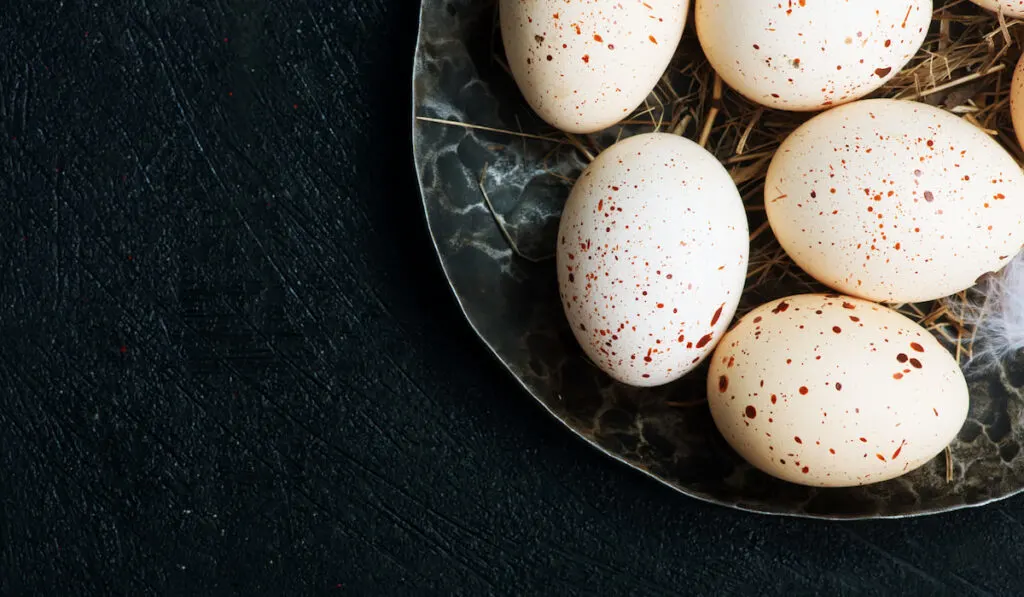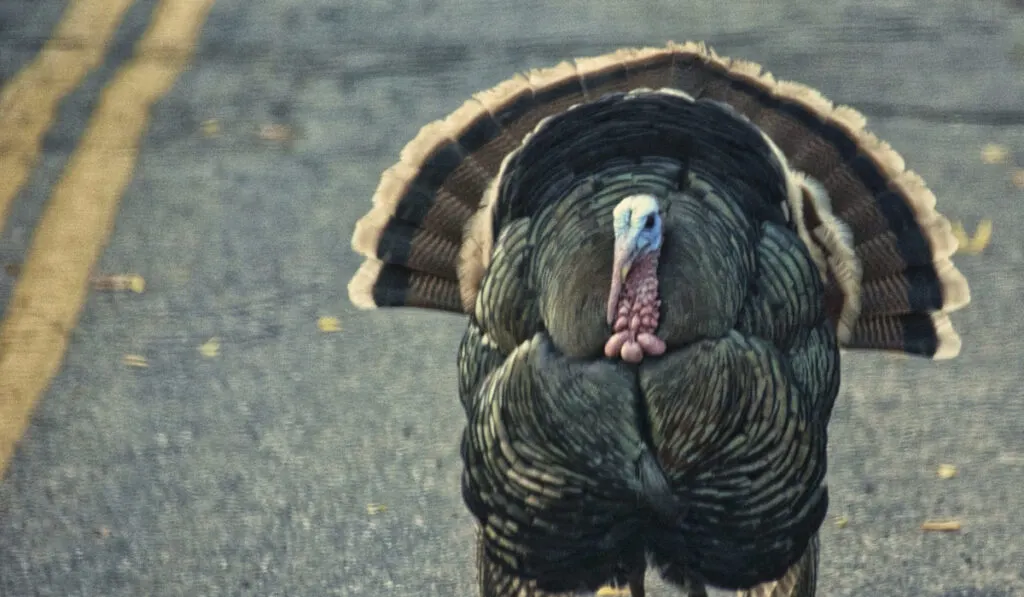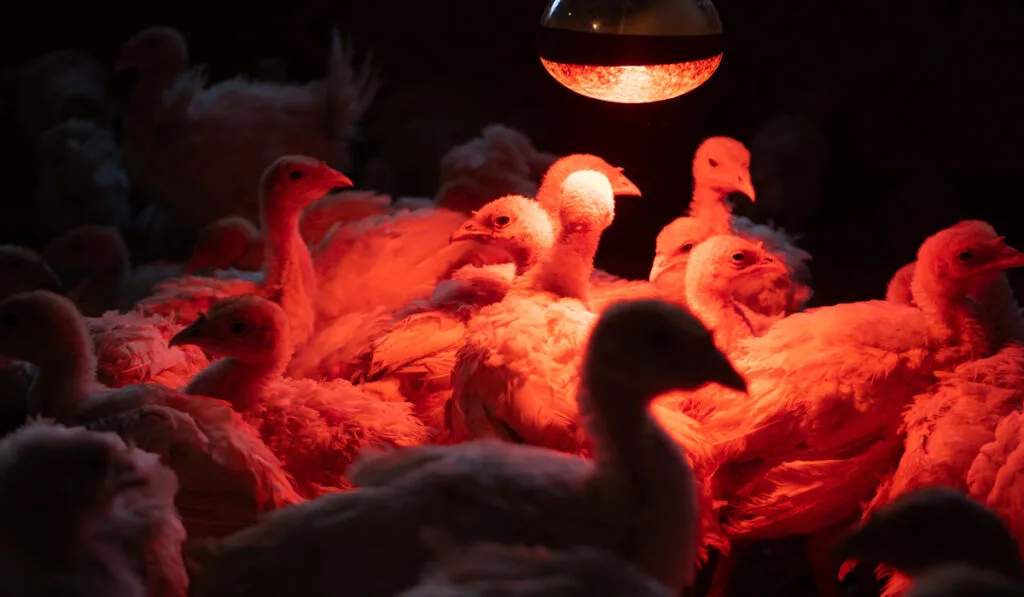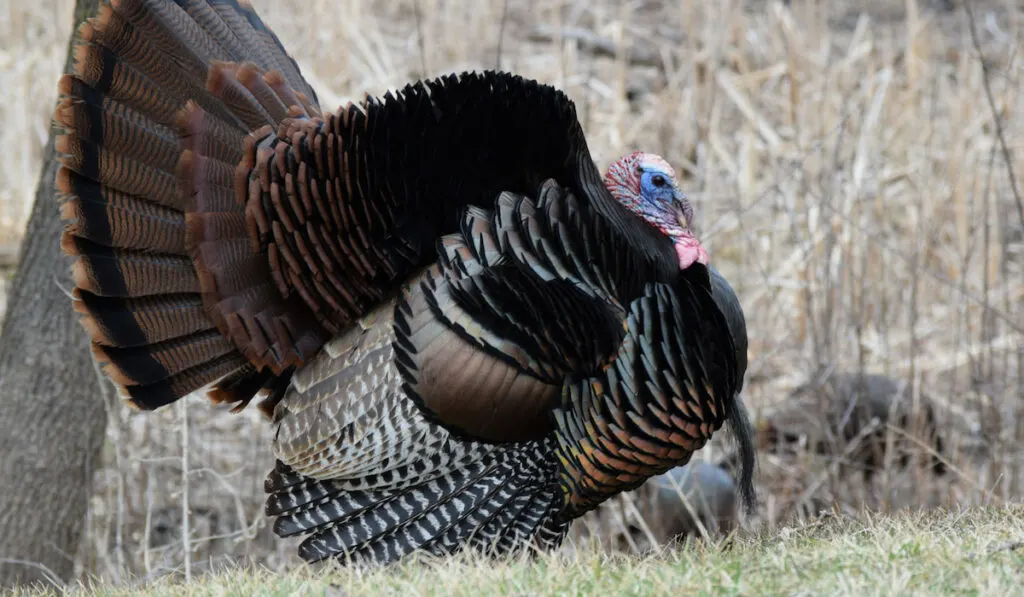Turkeys are wonderful birds to raise. They are large, majestic, and have a lot of uses. More and more homesteaders are beginning to raise turkeys. Why not you, too?
This article is your guide to get started on raising your own turkeys from chicks to adults.
Note that “chicks” are used in this article to refer to young turkeys which can also be called poults.
Table of Contents
Why Should You Raise Turkeys?
Are they easy to raise? Sure, Turkeys are easy to raise and fun to watch. There are a lot of reasons to raise turkeys. Here are just a few:
1. For Meat

Turkeys are among the largest bird species that people commonly raise. In just 5 months, turkeys can grow more than 30 pounds (for females) or 50 pounds (for males). This means that you a very large return on turkey meat at the end of the harvest.
Turkey meat is an extremely popular meat for any time of year (but especially the holidays).
2. For Eggs

Turkey eggs are way larger and sweeter than chicken eggs. The downside is that turkeys do not lay as many eggs as chickens. Most laying chicken breeds lay as much as 2 eggs in 3 days, but turkeys cannot lay more than 3 eggs weekly.
Even though turkeys do not lay as many eggs as chickens, you still get to enjoy turkey eggs.
3. Pest Control

Turkeys are great for pest control. In fact, most people raise turkeys to reduce pests in their yard. Examples of pests that turkeys eat are:
- Stinkbugs
- Spiders
- Ticks
- Rats
- Snakes
Turkeys can eat any and every little animal that they find. With a turkey around, you do not have to worry about pests.
4. Alarm or Security
One great reason people keep turkeys is that they act as an alarm. Turkeys have a high-pitched alarm call when an intruder enters your yard. Turkeys will also chase and peck the intruder. It’s actually pretty funny to watch. The higher and more frequent the alarm, the closer the intruder.
5. As an Exotic Pet

Some people keep turkeys to walk in their yard with majesty and grace. Turkeys are beautiful birds, so you could just keep yours as exotic pets.
With the numerous uses of turkeys, you definitely want to raise one, don’t you? Now before you raise turkeys, you need to know the best breed to raise.
How to Raise Turkey Chicks
The Nutritional Needs of Turkey Chicks
For every organism to grow, they need food. Foods rich in proteins and other nutrients help animals to grow quickly and in good health. The table below shows the protein needs of turkey chicks according to their age:
| Turkey Age | Protein Requirement |
| Weeks 0-4 | 28% |
| Weeks 4-8 | 26% |
| Weeks 8-12 | 22% |
| Weeks 12-16 | 19% |
| Week 16 and beyond | Around 15% |
(Source)
As you can see from the table above, the younger the turkey, the more protein it needs. This means that you need to provide the best quality of feed to your turkeys. At these young ages, the best feed for turkeys is processed feed.
Other sources of feed for turkeys are:
- Grains and seeds
- Insects
- Worms
- Insect larvae
- Fruits and vegetables
Give young turkey chicks processed feed. As they grow older, you can add other types of feed.
Temperature Needs of Turkey Chicks
Temperature is vital for the growth of turkeys. As young birds, turkeys lack the ability to regulate their body temperature, so they rely on an external heat source. The table below shows the temperature need of turkey chicks:
| Turkey Age | Temperature Requirement |
| 0-1 | 95° F |
| 1-2 | 90° F |
| 2-3 | 85° F |
| 3-4 | 80° F |
| 4-5 | 75° F |
| 5-6 | 70° F |
From the table above, it is clear that turkey poults need the highest temperture in their first week. Their temperature need reduces by 5° F every week until it gets to 70° F when they can leave the brooder box (or when they get complete feathers).
How to Give Your Turkey Chicks Sufficient Temperature
Here are tips to giving your poults sufficient temperature:
- Heat Lamps: The use of heat lamps is a very common method of giving heat to poults. One great thing about heat lamps is that you can change the height or regulate it to reduce/increase the temperature.
- Insulate the Brooder: You should line the brooder with non-toxic lazy conductors of heat, Bedding also helps to insulate the coop.
- Keep the Coop in a Warm Area: Keep it where it can be free from wind.

Must-Have Items to Raise Turkey Chicks
Aside from feed and clean water, here are must-have items to raise turkeys:
- Heat Lamps – As you already know, heat lamps provide sufficient heat for your poults. Heat lamps can also keep the pen in which adult turkeys will live later warm during the cold nights of winter.
- Bedding – Bedding is any material that can be placed below your chicks in their brooder to prevent them from walking on the bare floor.
- Spot to Roost – You should teach your turkey poults to roost before 6 weeks. Teaching them early will encourage them to quickly return to roost when they are matured.
Suitable Bedding for Turkey Chicks
- Paper Towel or Newspaper – Paper towels and newspapers are first on the list because they are the best for poults less than one week of age. If you give your poults other kinds of bedding, they may eat them and you do not want that.
- Wood Shavings – Wood shavings are a great bedding choice because they absorb moisture and prevent the brooder from having a bad smell. Wood shavings are wood pieces from tree barks, branches, etc.
- Shredded Paper – The shredded paper helps your turkey chicks to feel warm and cozy. The downside of this bedding material is that you have to change it more regularly than others.
- Hay or Straw – Hay or straw are great examples of bedding for your turkeys. Hay refers to dry grass while straw refers to the dried remaining parts of harvested grains such as wheat. Both hay and straw are great bedding ideas for your turkey chicks.
- Sawdust – Sawdust is also a bedding material that you can use, but you need to remove the dust so that your turkey chicks do not sneeze. Sawdust is best for older turkeys but can be used by poults (when it is the only option to choose from).

Interesting Breeds of Turkeys to Start With
Here are some recommended breeds of turkeys for you to raise:
- Bronze turkey
- Bourbon red turkey
- Broad breasted white turkey
- Narragansett turkey
- White Holland
All breeds mentioned above are beautiful and also very easy to raise. Now that you have selected the best breed to raise, it is time to get your poults
Getting Your Poults
- You can get poults from local farmers or even some feed mills
- Make sure that the poults are well-vaccinated (if needed)
- In summer, transport your poults in the morning, evening, or during cooler hours
- Prepare your brooder box before the poults arrive. You should already have heat lamps, bedding, etc. in the brooder box.
- Handle the poults gently
One of the fun things about getting turkey chicks is that you can name them. I prefer funny turkey names for my chicks but you can consider names based on color or gender as well!
Related Questions and Answers
1. When Will Your Poults (Turkey Chicks) Go Out?
In 6-7 weeks, your poults should be ready to go outside. As a general rule, you should wait until a third of your poults have developed their last feather before you take them out of the brooder. That being said, they can start to go out sooner depending on the weather.
Baby turkeys can start going outside as early as three weeks old if the weather is not too cold. You’ll still want to bring them in at night and shield them from drafts at this young age.
2. Can You Raise Just One Turkey?
The short answer is yes.
Unlike other birds, turkeys can be solitary and will not get depressed. If you feel that your yard space is not big enough for two turkeys or you cannot handle multiple turkeys, you can raise just one turkey.
Instead of raising your turkey from a chick, you can buy an adolescent or adult as well. Keep in mind that if you do raise your turkey from a chick, it will likely be more friendly with members of the household.
3. Do People Eat Turkey Eggs?
Turkeys do not lay as many eggs as chickens, so people who raise turkeys tend to leave the eggs to develop and hatch into turkey chicks. For people with many eggs, or farms with just a female turkey and no male turkey, you can certainly eat the excess eggs.
Turkey eggs don’t taste much different from chicken eggs. They can be used for everything from omelets to baking. You can even boil them for deviled eggs!
4. What Can You Do When Your Turkey is Sick?
Of course, the obvious answer here is to call the vet. Turkeys do not tend get sick quickly, so you can check what they eat and the weather conditions. Always consult the vet if your turkey isn’t feeling well.
If your turkey just seems to be under the weather, ensure they have adequate shelter and nutritious food. Your local feed store may be able to recommend vitamins for their water as well.
5. Can You Raise Turkeys and Other Birds Together?
You can raise turkeys along with other birds to maximize your profit. Here are examples of birds that you can raise with turkeys:
- Chickens
- Geese
- Guinea fowl
- Quails
- Pheasants
Final Thoughts
Turkeys are awesome birds to raise. You can raise them for meat, eggs, pest control, alarm, etc.
Remember to give your poults sufficient protein and temperature so that they can grow quickly and in good health.
Resources
- https://www.treehugger.com/raise-turkeys-from-poults-3016806
- https://askinglot.com/how-long-do-turkeys-take-to-grow
- https://www.roysfarm.com/how-to-start-raising-turkeys/
- https://www.motherearthnews.com/homesteading-and-livestock/raising-turkeys-at-home-zmaz01onzsel
